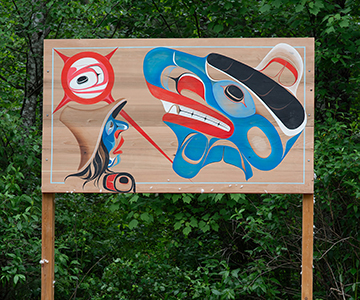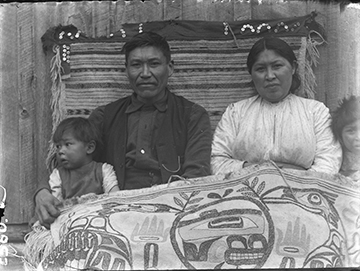Image Caption
Summary
Local Journalism Initiative Reporter
Windspeaker.com
Vancouver’s Museum of Anthropology (MOA) is opening its doors on Feb. 21 to the very first exhibition dedicated to the Nuxalk Nation.
The year-long show titled Nuxalk Strong: Dancing Down the Eyelashes of the Sun, will feature 71 treasures, artwork, dances, and stories acquired from private collections, six different museums and from the MOA’s own collection.
The Nuxalk Nation have lived for more than 14,000 years on the central Northwest Coast located at Bella Coola, B.C. They are recognized for their distinct style of painting, carving and weaving. Additionally, many of the treasures from the community incorporate a unique colour of blue used in their masks and regalia.

Since 2017, co-curators, Dr. Snxakila–Clyde Tallio, director of culture and language for the Nuxalk Nation, and Dr. Jennifer Kramer, curator, Pacific Northwest at MOA, have worked to develop the upcoming exhibit, which runs until Jan. 5, 2026.
“The title of the exhibit, Nuxalk Strong, comes from our hereditary chiefs back in the 80s and 90s when our hereditary chiefs were starting to reform as a hereditary council, starting to revitalize culture or potlatch and traditions,” said Tallio. “Our ancestral governance, and starting to fight for the land, and so this phrase became from one of their sort of slogans that they used at that time.”
The exhibit has become a way for Tallio and Kramer to be able to recognize that the path has been cleared by Elders and leaders from the community to be able to create an exhibit to showcase the continuing legacy of the Nuxalk people.
“The most exciting part to me, and also the Nuxalk themselves, is that this exhibit is going to serve as a physical reconnection for specific treasures, some of them that had been lost,” said Kramer. “This absolutely unique creative display of their history and totem poles and ancestry in all these different ways, and it’s never been on display.”
The co-curators brought together material treasures from six different museums around the West Coast and central area of Canada and Seattle, as well as treasures from the people of the area of Bella Coola. These items were all owned by the Nuxalk Nation collectively, or owned by individual families.
The Nuxalk community shared items from their private collections or “specific treasure boxes.”
“It is that physical and metaphorical container of one’s wealth and history, like dialogue and songs and regalia,” Kramer said.
Several of the items that will be displayed were considered “lost” by the community as they didn’t have any knowledge about where they had ended up once they left their home territories.
“So, this will be the first time in 50, 60, 70 years where community members will be able to reconnect,” said Kramer.
For instance, a talking stick had traveled with nine Nuxalk men to Germany in the 1880s.
“It was the first time the Nuxalk shared with the world who they were, and they traveled for a year before returning home,” said Kramer. “They had all kinds of publicity in Europe. This actual talking stick that was with them was identified in a private collection and will be on display.”
There is no one alive in the Nuxalk community who has actually viewed the treasure in person.
“So, it will be incredibly powerful because these are important ancestors that brought the knowledge of the Nuxalk Nation to the rest of the world,” she added.
Other items included in the exhibit are masks, a raven rattle, cedar bark weavings, and a head ring and neck ring.
Some of these items are being repatriated to the nation from ethnographer TF McIlwraith’s descendants. He collected the items when he worked with the community in the early 1920s.
“These treasures that were gifted to their grandfather and father are going to be in the exhibit and hadn’t been seen by the nation since 1923 when they left and went to Ontario where McIlwraith lived his life, and now will be in the exhibit and then will go home when the nation is ready,” said Kramer.
“So pretty powerful, all different examples of return and connection all on Nuxalk terms.”
Additionally, there will be videos, photos, workshops, two films and drone footage of the land to further enrich the experience of the Nuxalk culture for visitors.

“We wanted to be able to show how these teachings are still part of who we are today,” said Tallio.
“Late Elder Ama, she used to say that the treasures that are in the museums, they are different from every treasure before and every treasure after. That they are still doing work and that work that they do will help us clear the path for our future, for our sovereignty and for the next chapter of the human story to which Indigenous people will be a voice in, and our teachings will help us to share those values and worldviews.”
Tallio, who was trained as a potlach speaker by the Elders of the community for four years, will be adding a significant element to the exhibition.
He will be voice recording and giving a tour of the exhibit in English and in Nuxalk which people can download on their phone and listen to while they tour the exhibit.
“It’s as if you’ll be getting a tour from him, which will be really great,” Kramer said.
Local Journalism Initiative Reporters are supported by a financial contribution made by the Government of Canada.

